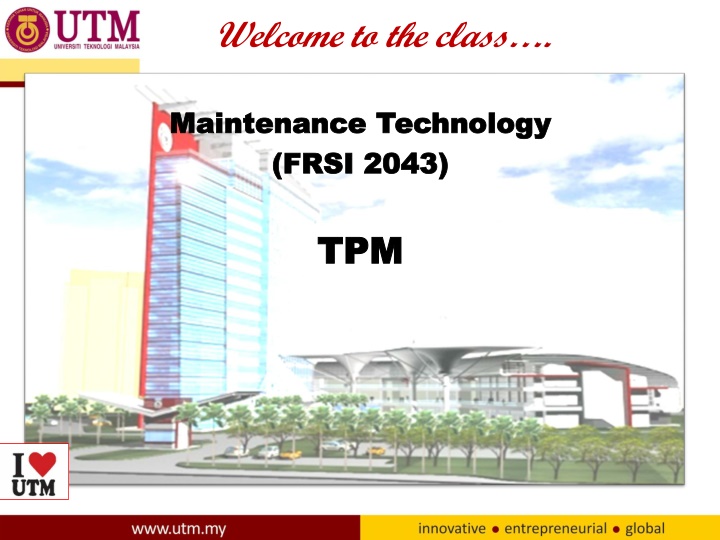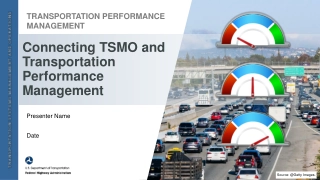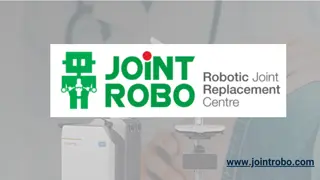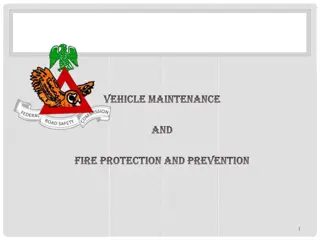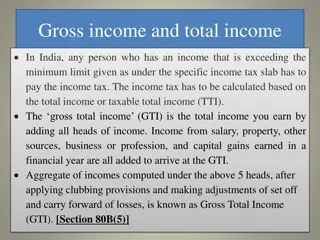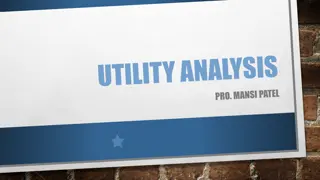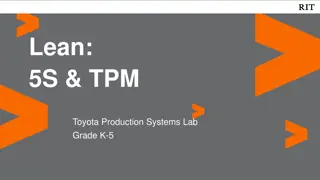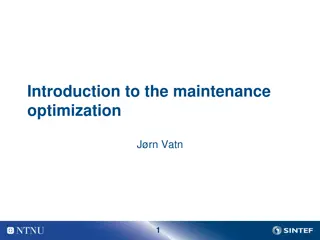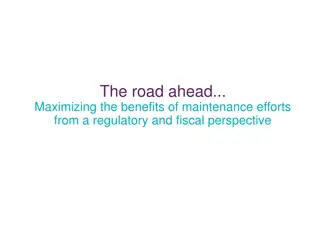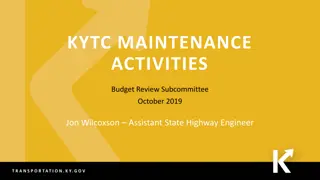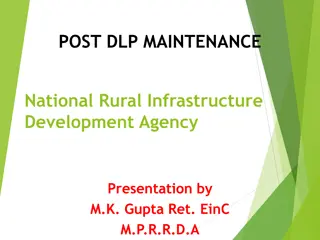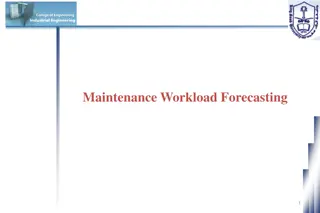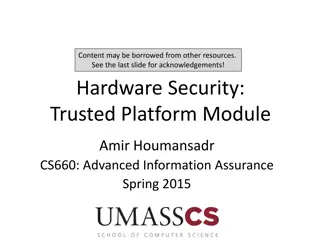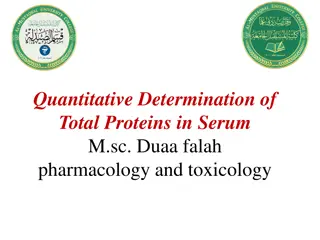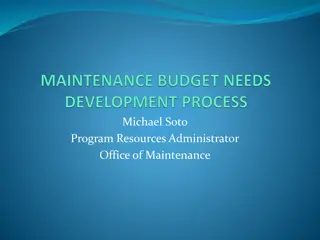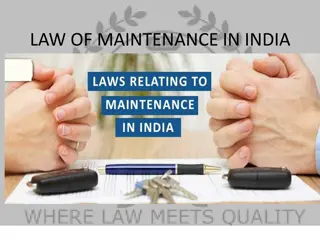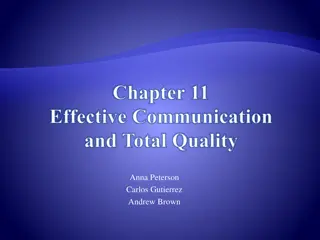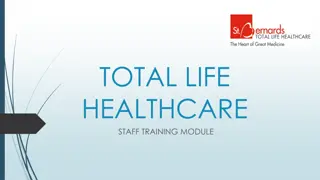Introduction to Total Productive Maintenance (TPM)
Total Productive Maintenance (TPM) is a comprehensive approach focusing on maximizing efficiency and productivity by involving all employees and departments in the maintenance process. Originating from Japanese industrial excellence principles, TPM aims to eliminate losses, defects, accidents, and breakdowns while promoting a culture of continuous improvement. Learn about the history, background, and key concepts of TPM to enhance your maintenance strategies effectively.
Download Presentation

Please find below an Image/Link to download the presentation.
The content on the website is provided AS IS for your information and personal use only. It may not be sold, licensed, or shared on other websites without obtaining consent from the author.If you encounter any issues during the download, it is possible that the publisher has removed the file from their server.
You are allowed to download the files provided on this website for personal or commercial use, subject to the condition that they are used lawfully. All files are the property of their respective owners.
The content on the website is provided AS IS for your information and personal use only. It may not be sold, licensed, or shared on other websites without obtaining consent from the author.
E N D
Presentation Transcript
Welcome to the class. Maintenance Technology Maintenance Technology (FRSI 2043) (FRSI 2043) TPM TPM
Lecture 4 Total Productive Maintenance
Total Productive Maintenance T: TOTAL Participation of all Employees. Includes all departments, operation, equipment and process. P: PRODUCTIVE Pursue the maximization of efficiency of the production system by making all loses zero. Zero accidents; Zero defects; Zero breakdowns. M: MAINTENANCE To improve the efficiency of the equipment. Maintenance means the entire life cycle of the production system. Maintenance is not only to repair and maintain the machines.
History of TPM TPM evolved from TQM, which evolved as a direct result of Dr. W. Edwards Deming's influence on Japanese industry. Dr. Deming began his work as a statistician in Japan shortly after World War II. Heinitially began to show the Japanese how to use statistical analysis in manufacturing and how to use the resulting data to control quality during manufacturing. The initial statistical procedures and the resulting quality control concepts fueled by the Japanese work ethic soon became a way of life for Japanese industry.
Background of TPM Main manufacturing excellence approach of Toyota and other excellent Japanese companies since the 70 s TPM is the foundation for JIT, FA, Poke Yoke, Lean Manufacturing and Zero Defects Comes from the best of Japanese Industrial Excellence and evolved from the heat of the continuing Energy Crisis and Globalization Challenges to achieve More with Less
Background of TPM - continue TPM brings maintenance into focus as a necessary and vitally important part of the business which was regarded as a non- profit activity. Down time for maintenance is scheduled as a part of the manufacturing day and, in some cases, as an integral part of the manufacturing process. It is no longer simply squeezed in whenever there is a break in material flow. The goal is to hold emergency and unscheduled maintenance to a minimum.
When to use TPM MARKET CIRCUMSTANCES IN-HOUSE CIRCUMSTANCES Easy funds for /capacity build up Market demand / consumption sluggish, High quality competition in the market Result - Stiff competition, low returns Opportunity to earn profit Increasing quality consciousness in market New plants very efficient and cost effective. Increasing input material cost Increasing wages and salaries. Rising cost of raw material Higher power cost & specific power Higher specific fuel consumption Higher man power cost Heavy losses, low profit due to equipment failures / low reliability / indifferent attitude Lower skill levels and involvement Compartmentalization, lack of horizontal communication Low moral/ organizational politics Unsafe working Pressure from top to progress fast CRISIS FOR THE COMPANY
TPM Objectives 1. Increase production while, at the same time, increasing employee morale and job satisfaction. 2. Hold emergency & unscheduled maintenance to a minimum. 3. To provide the safe and good working environment to the worker. 4. Achieve Zero Defects, Zero Breakdown and Zero accidents in all functional areas of the organization. 5. Involve people in all levels of organization. 6. Form different teams to reduce defects and Self Maintenance. 7. To maintain the HSE conditions of plant and equipments. 8. To fulfill regulatory compliances.
Benefit of TPM Direct benefits of TPM: 1. Increase in productivity and OEE (Overall Equipment Efficiency) 2. Reduction in customer complaints. 3. Reduction in the manufacturing cost. 4. Satisfying the customers needs by delivering the right quantity at the right time, in the required quality. 5. Reduced or eliminate accident at workplace.
Benefit of TPM Indirect benefits of TPM: 1. Higher confidence level among the employees. 2. A clean, neat and attractive work place. 3. Favourable change in the attitude of the operators. 4. Achieve goals by working as team. 5. Horizontal deployment of a new concept in all areas of the organization. 6. Sharing knowledge and experience. 7. The workers get a feeling of owning the machine.
TPM Targets 1. PRODUCTION Obtain Minimum 80% Overall Production Efficiency Obtain Minimum 90% Overall Equipment Effectiveness Machines run 24/7 2. QUALITY Operate in a manner, so that there are no customer complaint. 3. COST Reduce the manufacturing cost as much as possible. 4. DELIVERY Achieve 100% success in delivering the goods as required by the customer. 5. SAFETY
Components of TPM The Practical Components of TPM
TPM Base TPM starts with 5S. One can t see problems clearly when the workplace is in disarray. Cleaning and organizing the workplace helps the team to uncover problems. Making problems visible is the first step of improvement. Clean machines and workplace create pride & safety
TPM Base SEIRI SORTOUT Keep only essential items and eliminate what is not required, prioritizing things as per requirements and keeping them in approachable places. Everything else is stored or discarded. SEITON ORGANIZE There should be a place for everything and everything should be in its place. Each tool, part, supply, or piece of equipment should be kept close to where it will be used in other words, straightening the flow path. SEISO SHINE THE WORKPLACE Keep the workplace tidy and organized. At the end of each shift, clean the work area and be sure everything is restored to its place.
TPM Base SEIKETSU STANDARDIZATION Work practices should be consistent and standardized. Everyone should know exactly what his or her responsibilities are for adhering to the first 3 S's. SHITSUKE SELF DISCIPLINE When an issue arises such as a suggested improvement, a new way of working, a new tool or a new output requirement, review the first 4 S's and make changes as appropriate.
PILLAR 1: JISHU HOZEN Jishu Hozen = Autonomous Maintenance Policy 1. 2. Uninterrupted operation of equipments Flexible operators to operate & maintain other equipments Eliminating the defects at source through active employee participation Stepwise implementation of JISHU HOZEN activities. 3. 4. Jishu Hozen Targets 1. Reduce process time by predicted values. 2. Reduce oil/ lubricants consumption by predicted values. 3. Increase use of Jishu Hozen
Pillar 1: JISHU HOZEN Jishu Hozen Steps: 1. Preparation of employees 2. Initial cleanup of machines 3. Take counter measures 4. Fix tentative Jishu Hozen standards 5. General inspection 6. Autonomous inspection 7. Standardization 8. Autonomous management
Pillar 1: JISHU HOZEN 1. Train the Employees: Educate the employees about TPM, Its advantages, JH advantages and Steps in JH. Educate the employees about the equipment they use, the frequency of oiling, day-to-day maintenance activities required and the abnormalities that could occur in the machine and way to find out the abnormalities.
Pillar 1: JISHU HOZEN 2. Initial cleanup of machines: Arrange all items needed for cleaning. On the arranged date, employees clean the equipment with the help of maintenance department. Dust, stains, oils and grease has to be removed. When cleaning oil leakage, loose wires, unfastened nuts and bolts and worn out parts must be taken care. After clean up, problems are categorized and suitably tagged. White tags are place where operators can solve problems. Pink tag is placed where the aid of maintenance department is needed. Contents of tag are transferred to a register. Make note of area, which were inaccessible. Open parts of the machine are closed, and the machine is run.
Pillar 1: JISHU HOZEN 3. Counter Measures: Inaccessible regions had to be reached easily. E.g. If there are many screw to open a flywheel door, hinge door can be used. Instead of opening a door for inspecting the machine, acrylic sheets can be used. To prevent work out of machine parts necessary action must be taken. Machine parts should be modified to prevent accumulation of dirt and dust. 4. Tentative Standard: JH schedule has to be made and followed strictly. Schedule should be made regarding cleaning, inspection and lubrication and it also should include details like when, what and how.
Pillar 1: JISHU HOZEN 5. General Inspection: The employees are trained in disciplines like pneumatics, electrical, hydraulics, lubricant and coolant, fasteners and Safety. This is necessary to improve the technical skills of employees and to use inspection manuals correctly. The employees should share this with others. By acquiring this new technical knowledge, the operators are now well aware of machine parts. 6. Autonomous Inspection: Each employee prepares his own autonomous chart / schedule in consultation with supervisor. Parts, which have never given any problem, or part, which don t need any inspection, are removed from list permanently based on experience. Inspection that is made in preventive maintenance is included in JH. The frequency of cleanup and inspection is reduced based on experience.
Pillar 1: JISHU HOZEN 7. Standardization: The surroundings of machinery are organized. Necessary items should be organized, such that there is no searching and searching time is reduced. Work environment is modified such that there is no difficulty in getting any item. Everybody should follow the work instructions strictly. Necessary spares for equipments is planned and procured.
Pillar 2: KOBETSU KAIZEN (CQI) KAI + ZEN = KAI means change or improvement and ZEN means good (for the better). Kobetsu means focus. Basically Kobetsu Kaizen is for small adjustments and corrections but effects the whole process and carried out on a continual basis and involves all people in the organization. The principal behind is that a very large number of small improvements are more effective in an organizational environment than a few improvements of large value . This pillar is aimed at; Reducing losses in the work place that affect our efficiencies. losses in a systematic method using various Kaizen Tools.
Pillar 3: Planned Maintenance With planned maintenance, we evolve an effort from a reactive to a proactive method and use trained maintenance staff to help train the operators to better maintain their equipment. Policy: Achieve and sustains availability of machines Optimum maintenance cost. Reduce spares inventory. Improve reliability and maintainability of machines.
Pillar 3: Planned Maintenance Steps and Target: 1. Equipment evaluation and recording present status. 2. Restore deterioration and improve weakness. 3. Building up information management system. 4. Prepare time based information system, select equipment, parts and members and map on the plan. 5. Prepare predictive maintenance system by introducing equipment diagnostic techniques and 6. Evaluation of planned maintenance.
Pillar 3: Planned Maintenance Production Operators Clean & Check Observe Categorize Active Planned Maintenance Process Production Planning & Control Schedule P.M. Quality Engineers Standards & Calibrations Manufacturing Engineers Equipment Planning Equipment Studies
Pillar 4: Quality Maintenance It is aimed towards customer delight through highest quality and defect free manufacturing. Focus is on eliminating non- conformances in a systematic manner. Quality defects are classified as CUSTOMER END DATA and IN HOUSE defects . For customer-end data, we have to get data on Customer- end line rejection and field complaints. In-house data include data related to products and data related to process.
Pillar 4: Quality Maintenance Policy: Defect free conditions and control of equipments QM activities to support quality assurances. Focus of prevention of defects at source Focus on precaution (Pokayoke) system. In-line detection and segregation of defects. Effective implementation of operator quality assurance. Target: Achieve and sustain customer complaints at zero. Reduce in-process defects. Reduce cost of quality.
Pillar 5: Training It is aimed to have multi-skilled revitalized employees whose moral is high and who has eager to come to work and perform all required functions effectively and independently. Education is given to operators to upgrade their skill. The employees should be trained to achieve the form phase of skill which are as under: PHASE 1: Do not know. PHASE 2: Know the theory but cannot do. PHASE 3: Can do but cannot teach. PHASE 4: Can do and also teach.
Pillar 5: Training Policy: 1. Focus on improvement of knowledge, skills and techniques. 2. Creating a training environment for self-learning based on felt needs. 3. Training curriculum / tools /assessment etc conductive to employee revitalization 4. Training to remove employee fatigue and make, work enjoyable. Target: 1. Achieve and sustain downtime due to want men at zero on critical machines. 2. Achieve and sustain zero losses due to lack of knowledge / skills / techniques 3. Aim for 100 % participation in suggestion scheme.
Pillar 5: Training Steps in training activities: 1. Setting policies and priorities and checking present status of education and training. 2. Establish of training system for operations and maintenance skill up gradation. 3. Training the employees for up gradation the operation and maintenance skills. 4. Preparation of training calendar. 5. Evaluation of activities and study of future approach
Pillar 6: Office TPM Office TPM should be started after activating four other pillars of TPM (JH, Kaizen, QM, PM). Office TPM must be followed to improve productivity, efficiency in the administrative functions and identify and eliminate losses. This includes analyzing processes and procedures towards increased office automation.
Pillar 6: Office TPM Office TPM addresses twelve major losses. They are: 1. Processing loss 2. Cost loss including in areas such as procurement, accounts, marketing, sales leading to high inventories 3. Communication loss 4. Idle loss 5. Set-up loss 6. Accuracy loss 7. Office equipment breakdown 8. Communication channel breakdown, telephone and fax lines 9. Time spent on retrieval of information 10. Non availability of correct on line stock status 11. Customer complaints due to logistics 12. Expenses on emergency dispatches/purchases.
Pillar 6: Office TPM Office TPM and its Benefits: 1. Involvement of all people in support functions for focusing on better plant performance 2. Better utilized work area 3. Reduce repetitive work 4. Reduced administrative costs 5. Reduced inventory carrying cost 6. Reduction in number of files 7. Productivity of people in support functions 8. Reduction in breakdown of office equipment 9. Reduction of customer complaints due to logistics 10. Reduction in expenses due to emergency dispatches/purchases 11. Reduced manpower 12. Clean and pleasant work environment.
Pillar 6: Office TPM How to start office TPM? A senior person from one of the support functions e.g. Head of Finance, MIS, Purchase etc should be heading the sub- committee. Members representing all support functions and people from Production & Quality should be included in sub committee. TPM co-ordinate plans and guides the sub committee. 1. Providing awareness about office TPM to all support departments Identify the scope for improvement in each function Collect relevant data Help them to solve problems in their circles Make up an activity board where progress is monitored on both sides - results and actions along with Kaizens. Fan out to cover all employees and circles in all functions. 2. 3. 4. 5. 6.
Pillar 7: Safety, Health and Environment Target: 1. Zero accident, 2. Zero health damage 3. Zero fires. It focus on how to create a safe workplace and a surrounding area that is not damaged by the process or procedures. This pillar will play an active role in each of the other pillars on a regular basis. A committee is constituted for this pillar, which comprises representative of officers as well as workers. Manager (Safety) is looking after functions related to safety. To create awareness among employees various competitions like safety slogans, quiz, brochures, posters, etc. related to safety can be organized at regular intervals.
Difficulties faced in TPM implementation Typically people show strong resistance to change. Many people treat it just another Program of the month without paying any focus and also doubt about the effectiveness. Not sufficient resources (people, money, time, etc.) and assistance provided Insufficient understanding of the methodology and philosophy by middle management TPM is not a quick fix approach, it involve cultural change to the ways we do things Departmental barrier existing within Business Unit Many people considered TPM activities as additional work/threat.
